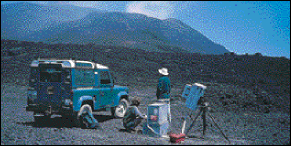Volcanic Gas Measured at a Safe Distance
Barbara GrantVolcanic gases offer important clues to atmospheric and subsurface processes, but methods that have proved safe have not proved easy. Scientists using ground-based IR remote-sensing techniques to analyze volcanic plume gases must often contrive difficult measurement geometries involving an IR source, a spectrometer and the plume. This often forces them to locate their experiments close to the volcano, putting individuals at risk in the event of volcanic activity.
 Researchers using a solar occultation method to analyze volcanic gases configured their FTIR system on the summit of Mount Etna, which emits thousands of tons of sulfur dioxide every day. By taking measurements when the plume passes between the telescope and the sun, researchers were able to determine the plume's gaseous composition.
Researchers using a solar occultation method to analyze volcanic gases configured their FTIR system on the summit of Mount Etna, which emits thousands of tons of sulfur dioxide every day. By taking measurements when the plume passes between the telescope and the sun, researchers were able to determine the plume's gaseous composition.
"Volcanoes are not laid out for convenience," said Peter Francis, professor of volcanology in The Open University's department of earth sciences. To provide greater safety in ground-based measurements, Francis' team has used solar occultation spectroscopy to remotely analyze plume gases with a Fourier transform infrared (FTIR) spectrometer.
By using the sun as the IR source, it also obtains higher signal-to-noise ratios for certain constituents, he said. The only geometric constraint is that researchers must view the sun through the plume, which enables them to employ a variety of measurement configurations.
The team applied the technique in measurements at low sun angles on the Caribbean island of Montserrat and in cases where thin clouds partially obscure the sun. High elevations without interference from water vapor or falling ash are prime locations for the solar method, Francis said.
The researchers hope that several planned improvements to the FTIR system will allow greater use of the solar occultation method in volcanic plume analysis.
LATEST NEWS
- CLEO Heads to the East Coast Apr 29, 2024
- Laser-Based Gas Analyzer Developed to Detect Air Pollution Apr 29, 2024
- Qubits Could be Stored in Flash-Like Memory Apr 29, 2024
- Exail Signs LLNL Contract, Partners with Eelume Apr 26, 2024
- Menlo Moves U.S. HQ: Week in Brief: 4/26/2024 Apr 26, 2024
- Optofluidics Platform Keys Label-, Amplification-Free Rapid Diagnostic Tool Apr 25, 2024
- DUV Lasers Made with Nonlinear Crystals Enhance Lithography Performance Apr 25, 2024
- Teledyne e2v, Airy3D Collaborate on 3D Vision Solutions Apr 24, 2024
